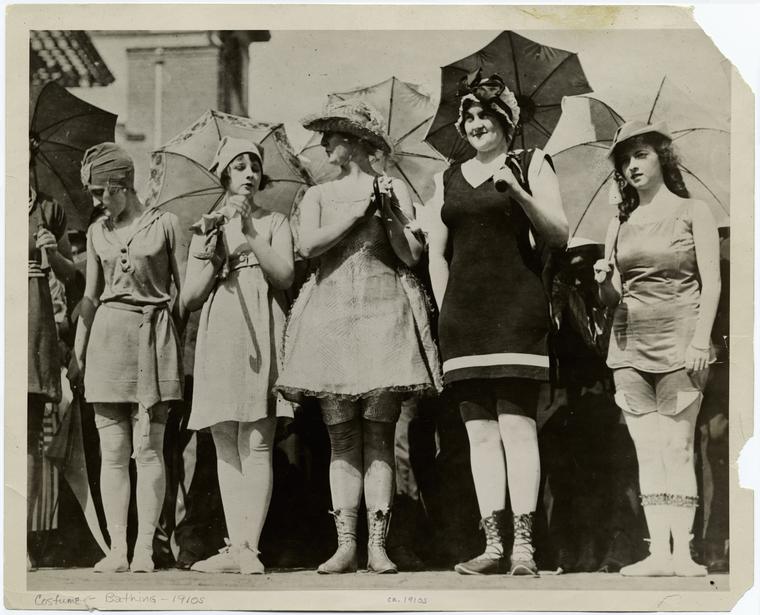Paperless Research
Exploring the History of the Swimsuit with NYPL's Electronic Resources
Summer is halfway over, which means it's time to take advantage of cooling off during these hot days by taking a dip in the ocean, the lake, or your community swimming pool. Swimming and spending time in the water is one of the most popular summer pastimes, which is why it is often referred to as "swimsuit season." Oxford Dictionaries Online defines a swimsuit simply as, "a garment worn for swimming," but we know it is much more than that. A swimsuit is a fashion statement and sometimes even a political statement. So how did the swimsuit, as we know it today, come about? The New York Public Library has a number of great fashion related electronic resources for anyone interested in current and historical fashions. To name just a few, patrons can access the Vogue Archive, the Harper's Bazaar Archive, the Berg Fashion Library, Women's Wear Daily, and most recently the entire run of Vogue Italia. By exploring these databases we can take a look back at the history of the swimsuit.
1800s
Prior to the Victorian era people bathed and washed in open waters, but it was not until there was a scientific understanding of disease and bacteria in the nineteenth century that people began to fearlessly enter the oceans and rivers and enjoy the waters as a recreational activity. However, in the nineteenth century modesty was all the rage and women entered the oceans wearing bathing outfits made from wool, accompanied by wool stockings and corsets. After a period of splashing around in the water these garments would become extremely heavy, and it didn't help that some women had weights sewn into the hems of their bathing dresses to stop any indecent floating-up. It's no wonder that towards the end of the century women desired something a little less cumbersome as swimming began to turn from recreation to sport.

1900s
Although still made of wool, women's swimsuits in the early 1900s saw some improvement, with the pants being replaced by skirts attached to one-piece outfits that fit firmly against the body. However the stockings were still a standard part of early twentieth century swimwear. But as the first decade of the twentieth century progressed so did the swimsuit, becoming more functional with skirts and lightweight tops covering shorts.


1920s
Swimwear during the 1920s followed the popular flapper movement with more revealing attire by doing away with the stockings, sleeves, and aproned skirts. Also, inline with the Art deco movement of the period, swimsuits began to feature bright colors and prints.

1940s
The next great change in swimwear followed the second World War. French mechanical engineer, Louis Reard, revolutionized the bathing suit with his new invention, the bikini. Beginning in the 1920s women were already wearing two-piece swimsuits, but the bikini was the skimpiest bathing suit yet. Diana Vreeland, fashion editor extraordinaire, said that the bikini revealed "everything except her mother's maiden name." In 1947 Harper's Bazaar was the first magazine to feature the bikini in its May 1947 issue. However, despite the general reaction to the bikini, it did not catch on until the late 1960s.

As science and fashion have evolved so has the swimsuit. Fashion designers have continued to experiment with colors and cuts, while fabrics have evolved to assist athletes in speed and efficiency. If you want to learn more about the history of the swimsuit or have an interest in fashion visit the many fashion databases accessible to all our patrons and don't forget to explore the NYPL Digital Collections. This blog post was researched entirely using NYPL's electronic resources. With more than 500 online research options available, many accessible from home with a library card, we challenge you to go beyond the search engine and dig deeper online with NYPL.
Resources
"Bathing Costumes." Fashion, Costume, and Culture: Clothing, Headwear, Body Decorations, and Footwear through the Ages, edited by Sara Pendergast and Tom Pendergast, vol. 3: European Culture from the Renaissance to the Modern Era, UXL, 2004, pp. 608-610. Gale Virtual Reference Library. Accessed 21 July 2017.
Loschek, Ingrid. "Twentieth-Century Fashion." Encyclopedia of Clothing and Fashion, edited by Valerie Steele, vol. 3, Charles Scribner's Sons, 2005, pp. 348-353. Gale Virtual Reference Library. Accessed 21 July 2017.
"Swimwear." Fashion, Costume, and Culture: Clothing, Headwear, Body Decorations, and Footwear through the Ages, edited by Sara Pendergast and Tom Pendergast, vol. 4: Modern World Part I: 1900-1945, UXL, 2004, pp. 745-747. Gale Virtual Reference Library. Accessed 21 July 2017.
Getting Started: Researching Fashion with NYPL's Electronic Resources
Critical Studies in Fashion & Beauty
Fashion, Style & Popular Culture
International Journal of Fashion Studies
Read E-Books with SimplyE
 With your library card, it's easier than ever to choose from more than 300,000 e-books on SimplyE, The New York Public Library's free e-reader app. Gain access to digital resources for all ages, including e-books, audiobooks, databases, and more.
With your library card, it's easier than ever to choose from more than 300,000 e-books on SimplyE, The New York Public Library's free e-reader app. Gain access to digital resources for all ages, including e-books, audiobooks, databases, and more.
If you don’t have an NYPL library card, New York State residents can apply for a digital card online or through SimplyE (available on the App Store or Google Play).
Need more help? Read our guide to using SimplyE.
